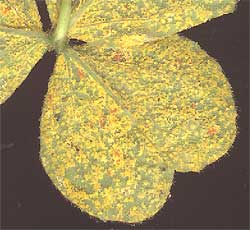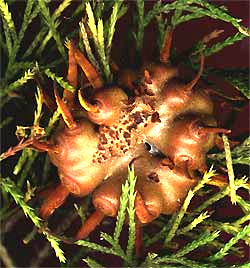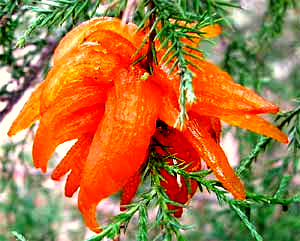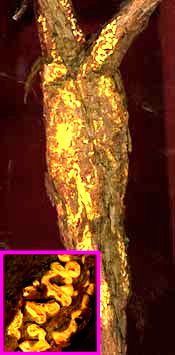(SOURCE: NCBI database)
KINGDOM: Fungi
DIVISION: Basidiomycota
CLASS: Pucciniomycetes
ORDER: Pucciniales
FAMILIES: several

As of 2021, about 7000 species of rust are recognized and all are parasitic on plants and normally restricted to specific parts of the plants, such as leaves, petioles, tender shoots, stems, fruits, etc. No other group of fungi is as dangerous to agricultural and horticultural crops. At the left a rust disease appears on the undersides of Oxalis leaflets. It's caused by the fungus Puccinia oxalidis. The yellow spots are spore-producing "fruiting bodies."

The life histories of rusts are complex, often with the fungus spending part of its life on one kind of plant, then another part on a completely different kind. For example, at the right you see part of a branch of the Eastern Redcedar, Juniperus virginiana, afflicted with a tumor-like growth caused by the Cedar-apple Rust, Gymnosporangium juniperi-virginianae.
During the winter the brown, bumpy, woody, tumor-like growths about size of golf balls remained unchanged. In early spring the growths developed the slender, sharp, curving "horns" seen emerging from bumps on the growth.

When rains came, the horns quickly enlarged to form the orange, gelatinous masses seen at the left. When the gelatinous masses dried out, they disintegrated into a huge number of spores (teliospores, with genes from two parent strains, so 2n). Wind carried the spores -- if they were lucky -- to an apple or crabapple tree where they infected newly emerging growth.
Inside the leaves, two strains of the fungus must meet in order to mate and produce a new kind of spore (basidiospores, with genes from only one parent strain, so n). This process causes a disease on the apple or crabapple tree; spots appear on the leaves. Eventually many leaves fall off too early, weakening the tree, and the fruit may be damaged. Spores (aeciospores, with genes from two parent strains, so 2n) produced in the leafspots are then blown back to redcedars during a time frame of mid summer to fall. The spores germinate and infect the tree, forming growths over a period of about 17 months, and the whole cycle begins again.
That's the life cycle of just one of the 7000 species forming fungal rust, and it's fairly typical. Here's another:

At the right, the trunk of a young Loblolly Pine, Pinus taeda, is infected by Fusiform Rust, Cronartium quercuum f. sp. fusiforme. At this stage, if you knock against the trunk, a cloud of orange powder is released from the blisters. This powder is composed of tiny aeciospores. These aeciospores land on oak leaves where later in spring pustules known as uredia will appear on the oak leaves' undersurfaces. During late spring or early summer, brown, hairlike structures called telia will form on the oak leaves. These telia will produce teliospores which will germinate into basidiospores, which will infect a pine and cause the infection shown at the left, starting the life cycle over again.
This is a serious disease for Loblolly and Slash Pines in the US Southeast. Infections occurring on the main stem within the first 5 years of a tree's life normally cause tree death.